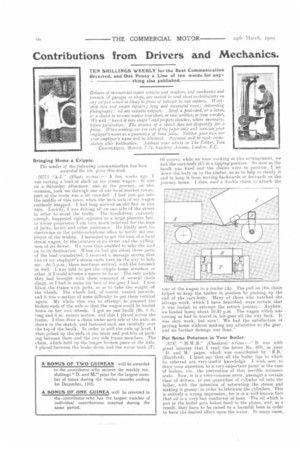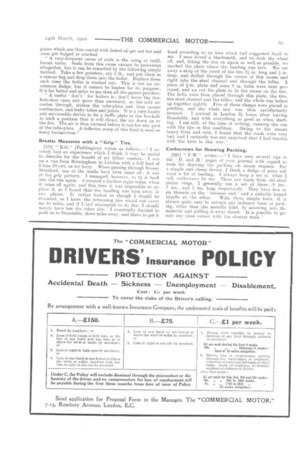Contributions from Drivers and Mechanics.
Page 20

Page 21

If you've noticed an error in this article please click here to report it so we can fix it.
TEN SHILLINGS WEEKLY for the Best Communication Received, and One Penny a Line of ten words for any thing else published.
Drivers of commercial-motor vehicles and tractors, and mechanics and foremen of garages or shops, are invited to send short contributions on any sztVect wrath is likely to prove of interest to our readers. Workshop tips and smart repairs ; long and successful runs ; interesting Photographs all are suitable subjects. Send a post-card, or a letter, or a sketch to us—no matter how short, or how written, or how worded. We will " knock it into shape" and prepare sketches, where necessary, before publication. The absence of a sketch does not disqualify for a prize. When writing use one side of the paper only and mention your employer's name as a guarantee of bona jides. Neither your own nor your employer's name will be disclosed. Payment will be made immediately after Publication. Address your letters to The Editor, THE COMMERCIAL MOTOR. 7-15, Rosebery Avenue, London, E.C.
Bringing Home a Cripple.
The sender of the following communication has been awarded the 10s. prize this week.
[672] "A.J." (Flint) writes:—'• AL few weeks ago. I was carting a load of slack on my steam wagon. It ‘i as on a Saturday afternoon, and as the journey, on this occasion, took me through one of our local market towns. part of the route was a bit crowded. I had just got into the middle of this town, when the hack axle of my wagon suddenly snapped. I had long noticed an old flaw in this axle. Luckily, I was driving all on tine side of the street in order to avoid the traffic. The breakdown, curiously enough, happened right opposite to a large pleasure fair, to whose proprietor I am very much indebted for the loan of jacks, levers and other assistance. He kindly sent his electrician to the public-telephone office to notify my employer of the mishap. I managed to get the loan of a local steam wagon, by the courtesy of its owner and the willingness of its driver. We were thus 'enabled to take the load on to its destination. When we had got about three parts of the load transferred, I received a message saying that two of my employer's steam carts were on the way to help me. At 5 p.m., these machines arrived, with the foreman as well. I was told to get the cripple home somehow or other, if I could scheme a means to do so. The only tackle they had brought with them consisted of several chain slings, so I had to make the hest of the gear I had. I first lifted the frame with jacks, so as to take the weight off the wheels. The wheels had, of course, canted inwards, and it was a matter of some difficulty to get them vertical again. My whole idea was to attempt to suspend the broken ends of the axle so that the wagon could be hauled home on her own wheels. I got an oak baulk (B). 5 ft. long and 6 in. square section. and this 1 placed across the frame. I then drew a chain under each side of the axle, as shown in the sketch, and fastened each one carefully over the top of the baulk. In order to pull the axle up level, I then prised up the ends of the beam and put bits of packing between them and the two side frame members. The chain, which held up the longer broken piece of the axle, I placed between the braise drum and the water tank (T).
Of coursa, while we were working at this arrangement, we had the cart-body (C) in a tipping position. So soon as the baulk was fixed and the chains were in position, I let down the body on to the timber, so as to help to steady it and to keep it from moving backwards or forwards on the journey home. I then used a double chain to attach the
rear of the wagon to a trailer (A). The pull on this chain helped to keep the timber in position by pushing up the end of the cart-body. Many of those who watched the salvage work, which I have described, were certain that it was foolish to attempt the return journey. Anyhow, we landed home about 10.30 p.m. The wagon which was towing us had to travel in low-gear all the way back. It was slow work, but sure! We had the satisfaction of getting home without making any alteration to the gear, and no further damage was done."
Put Some Potatoes in Your Boiler.
[678] " FI.W.B." (Cheshire) writes :—" It was with great interest that I read the letter No. 670, in your ' D. and M.' pages, which was contributed by E.B.' (Dartford). I must say that all the boiler tips to which he referred are very-useful knowledge. I wish now to draw your attention to a very-important point in the case of boilers, viz., the prevention of that terrible nuisance scale. Now, it is a very-common error, amongst a certain class of drivers, to put quantities of cylinder oil into the boiler, with the intention of saturating the steam and making it greasy, in order to lubricate the cylinders. This is entirely a wrong impression, for it is a well-known fact that oil is a very-bad conductor of heat. The oil which is put in the boiler gets baked hard to the plates, and, as a result, they have to be raised to a harmful heat in order to have the desired effect upon the water. in ninny cases,
plates which are thus coated with baked oil get red hot. and soon get bulged or cracked.
" A very-frequent cause of scale is the using of indifferent water. Scale from this cause cannot be prevented altogether, but it can be remedied by the following simple method. Take a few potatoes, say 5 lb., and put them in a canvas bag and drop them into the boiler. Replace these each time the boiler is washed out,. This is not an uncommon dodge, but it cannot he beaten for its purpose ; it is far better and safer to use than all the patent powders. " A useful don't ' for boilers is: don't leave the firehole-door open any more than necessary, as the cold air rushes through, strikes the tube-plate and thus causes contraction, and leaky tubes and joints. It is a very-handy and serviceable device to fix a baffle plate in the fire-hole in such a position that it will direct the air down on to the fire. The air is thus warmed before it reaches any part of the tube-plate. A deflector scoop of this kind is used on many locomotives."
Drastic Measures with a "Grip" Tire.
[679] " E.G." (Paddington) writes as follows.—" I recently had an experience which I think it may be useful to describe for the benefit of my fellow readers. I was on a run from Birmingham to London with a full load of 2 tons 10 cwt. on my lorry. When passing through Stoney Stratford, one of the inside hack tires came off : it was of the grip pattern. I managed. however, to fit it back into the rim again. I covered a further eight miles, when it came off again, and this time it was impossible to replace it, as T found that the beading was torn away in two places. It. rather looked as though I should he stranded. as I knew the remaining tire would not carry me 40 miles, and if I had attempted to do this. I should merely have lost the other tire. I eventually decided to push on to Dunstable, three miles away. and there to get it fixed according to an idea which had suggested itself to me. I soon haunt a blacksmith, and we took the wheel off, and, fitting the tire on again as well as possible, we marked the place where the beading was torn. We cut away a strip of the tread of the tire 2"y in. long and in. deep, and drilled through the centre of this recess and right into the steel channel and through the felloe. A piece of plate and some 6 in. bolts were next procured, and we cut the plate to lit the recess on the tire. The bolts were then placed through this plate, the tire, the steel channel and the felloe, and the whole was bolted up together tightly. Five of these clamps were placed in position, and the whole tire was thus satisfactorily secured. I arrived in London 31 hours after leaving Dunstable, and with everything U.S good as when starting. I am still, at the time of writing, running the van with the tire in this condition. Owing to the recent heavy frost and rain, I found that the roads were very bad, and I certainly was not surprised that I had trouble with the tires in this way."
Corkscrews for Drawing Packing.
[680] " F.W." writes :—" I have seen several tips in the D. and M.' pages of your journal with regard to tools for drawing the packing on steam engines. For a simple and cheap device, I think a dodge of mine will want a lot of beating. I always keep a set of. what I call, corkscrews by me. These are made from old steel piston rings. I generally use a set of three —9 ins.. 7 ins., and 5 ins, long respectively. They have live or six threads on the business end,' and a suitable looped
handle at the other. With these simple tools, it is always quite easy to extract any ordinary form of packing, other than the metallic kind, by screwing into the material and pulling it away direct. It is possible to get into any close corner with the shorter tools."






















